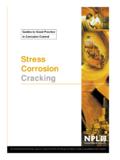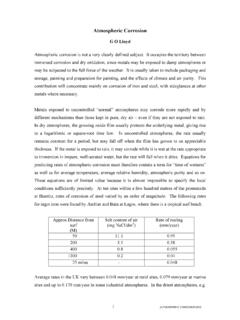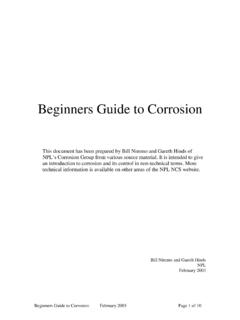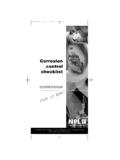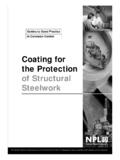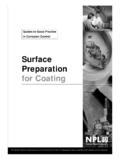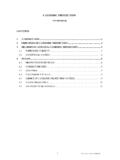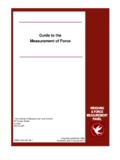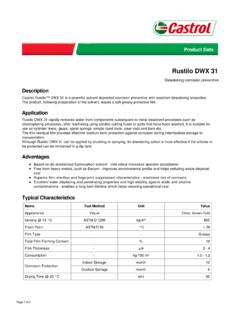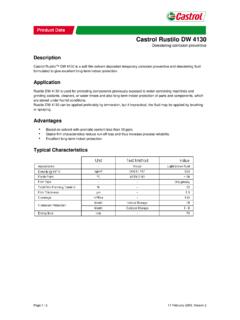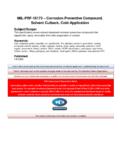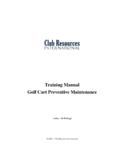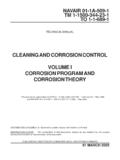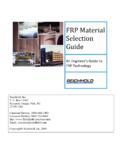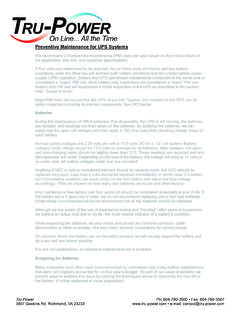Transcription of guide to temporary corrosion protectives vs2
1 2003, National corrosion Service, NPL Page 1 of 16 guide to temporary corrosion protectives . Contents 1. Introduction 2. Purpose What are they for? 3. Fields of Use Where are they used? 4. Generic Types What types are available? 5. Multifunctional protectives 6. Environmental Considerations 7. Precleaning and Removal 8. How to Select 9. Summary 10. Further Sources of Information, Reference and Guidance 2003, National corrosion Service, NPL Page 2 of 16 1. Introduction Many of the metallic parts, components, and finished machines produced by the manufacturing industries may have bare metal surfaces which require to be protected until brought into use, or receive interstage protection prior to further assembly or processing.
2 They may be finished metallic parts, which need to receive some form of protection from corrosion during shipping or storage, or they may require some form of protection from corrosion whilst in use. Typical examples are automotive parts which require protection for a few days, weeks or months, fasteners, steel strip, steel sections, drawn sections of steel, aluminium alloys, or yellow metals etc, during a delay in the manufacture and supply schedule. In some cases, the parts may need to be protected after machining, and if this has been carried out with a water miscible coolant, then the parts may need to be dewatered or dried as part of the overall protection.
3 The metal to be protected may be ferrous, aluminium alloy, copper based alloys, or other non-ferrous materials, each of which may require a different specific approach to the formulation of the protective . The metal may be part of an assembly together with other metals, with plastics or rubber seals, and contact compatibility with other parts of the assembly will require consideration. In many cases, the overall protection is provided by a combination of individual materials, such as a surface coating in combination with outer wrapping, often combined with VCI (vapour phase corrosion inhibitors).
4 For instance, a machined part may be dewatered, the same dewatering fluid may leave a protective film, which is then augmented by wrapping in VCI treated paper, or stored in VCI poly-film containers. It is therefore important that both corrosion protection and subsequent packaging be considered together, not in isolation. The use of some VCI products on their own allow protection without the inhibitor being in direct contact with the protected surface enabling use or assembly without the need for removal. Sometimes, the temporary protective may perform other additional functions, such as serve as a lubricant or as a cleaning fluid.
5 As a lubricant it may be, for instance, for press forming of steel strip, where the same coating carries out both the corrosion protection and the lubrication of the forming process. As a cleaner, it may be used for rinsing or cleaning machined parts, and the film left by the cleaner may serve also as the temporary protective . This guide helps to explain the concept of temporary corrosion protection, it describes the various types of protection available, points to ongoing trends, and gives guidance in the selection and application.
6 2003, National corrosion Service, NPL Page 3 of 16 2. Purpose - What Are They For? A temporary corrosion protective is by definition a material that can be easily removed from the metal surface after treatment. It is not designed to be permanent, or difficult to remove in the same way as a paint system or plastic coating. The material may need to provide protection when exposed to a variety of differing corrosive atmospheres, indoors, outdoors either under cover or fully exposed, in a marine environment, under effects of direct sunlight, perhaps in a radiation flux, in the presence of specific chemical corrosives in an industrial environment etc During its protective period, it needs to give adequate freedom from corrosion of bare metal surfaces for a predetermined length of time in manufacture, assembly, storage or distribution.
7 The term of protection will need to be determined for each application, in line with other requirements, and the type of protective selected to suit. Since temporary protectives are invariably used in inter-stage manufacturing operations, they may need to be compatible or in harmony with later stages in the production operations. Particularly compatibility with any materials such as paints, adhesives, sealants etc., which may be applied to the metal surface at a later stage is important, even though there may be prior removal/ degreasing/ cleaning operations.
8 3. Fields of Application Where Are They Used? The different uses and applications for temporary protectives include the following: Steel and coated steel strip Steel profiles, sections and tubes Aluminium or other alloy strip and sections Machined parts and components either as finished items or for later assembly Tools and machine tools in manufacture, storage and supply Fasteners such as screws, rivets, bolts, etc Machinery parts, either finished or for later assembly Automotive components and sub-components Electrical parts and assemblies Construction and off-highway equipment Metal tanks, valves.
9 And lines Agricultural parts and machinery Vehicles or machinery protected in shipment Assemblies of equipment, moth-balled for long or short periods 2003, National corrosion Service, NPL Page 4 of 16 4. Generic Types What Varieties of protective Are Available? A number of different types of temporary protective are classified in BS1133:1991, Section , Protection of Metal against corrosion during Transport and Shipment, temporary protectives and their Application; these designations are also used below. There are however a number of other classifications or specifications for achieving temporary protection from corrosion for example the UK Ministry of Defence have their own corrosion Preventatives specified in Defence Standard 01-05 issue 13 section 4 PX- corrosion Preventatives; some of these have NATO Reference numbers and all have NATO Stock Numbers.
10 The USA specify similarly under MIL Specification Numbers. The classifications and designations in BS1133 are A. Solvent based fluids: Coatings deposited on surfaces by the evaporation of solvents. TP 1 a Deposits a hard film, quick drying TP 1 b Deposits a hard film, slow drying TP 1 c Deposits a hard film, slow drying also displaces moisture from wet surfaces TP 2 a Deposits a soft film following solvent evaporation TP 2 b Deposits a soft film also displaces moisture from wet surfaces Solvent-based fluids, which deposit a coating after the carrier solvent has evaporated, have been a traditional form of protection for some years.
